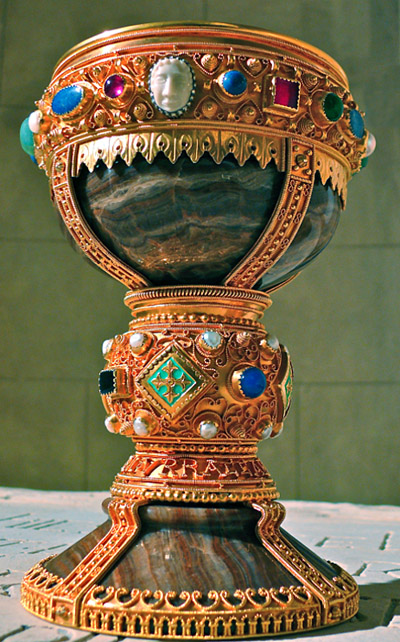April 9th, 2014
The search for the Holy Grail may be over. Two historians claim that the jewel-encrusted golden chalice displayed in Spain’s San Isidro Basilica is the actual cup shared by Jesus Christ and his Apostles during the Last Supper.
The surprising revelations of León University medieval history lecturer Margarita Torres and art historian José Manuel Ortega del Rio were published last week in their book, "Kings of the Grail."
News of the much-sought-after chalice, which played key roles in the 1970s British comedy Monty Python and the Holy Grail and Dan Brown's controversial thriller The Da Vinci Code, resulted in a deluge of visitors to the basilica’s small museum. Curators were forced to pull the chalice from its exhibit while they tried to find a larger space to accommodate the crowds, according to The Guardian.
"It was in a very small room where it was not possible to admire it to the full," museum director Raquel Jaén told AFP.

The oversized onyx chalice, which is adorned with agate, gold and other precious stones, is actually two goblets connected bottom to bottom. The historians believe that Christ drank from the top chalice long before it was doubled in size and bejeweled.
Before del Rio and Torres identified the chalice as the holy grail, the vessel had been known less spectacularly as the goblet of the Infanta Dona Urraca, the daughter of the King of León, who ruled from 1037 to 1065.
A piece of Egyptian parchment found three years ago by the historians at Cairo’s University of Al-Azhar offered clues regarding the whereabouts of the Holy Grail. Torres and del Rio traced the origins of the chalice to the early Christian communities of Jerusalem.

Credit: José-Manuel Benito Álvarez/Wikimedia Commons.holygrail
The historians are convinced that the chalice was transported to Cairo by Muslim travellers and then handed to an emir in Spain who had assisted victims of an Egyptian famine.
Torres reported that Spanish royalty originally obtained the grail in the early 11th century as a peace offering from the emir of the Muslim part of Spain.
Torres and del Rio further backed their claim with a carbon dating test on the chalice that revealed it was fabricated between 200 BC and 100 AD.
"The only chalice that could be considered the chalice of Christ is that which made the journey to Cairo and then from Cairo to León — and that is this chalice,” Torres said.
Before you accept the historians’ conclusion that this chalice is the real deal, keep in mind that Europe holds claim at least 200 “Holy Grails,” all believed to be the sacred vessel from which Jesus himself drank on the night before he died.
The surprising revelations of León University medieval history lecturer Margarita Torres and art historian José Manuel Ortega del Rio were published last week in their book, "Kings of the Grail."
News of the much-sought-after chalice, which played key roles in the 1970s British comedy Monty Python and the Holy Grail and Dan Brown's controversial thriller The Da Vinci Code, resulted in a deluge of visitors to the basilica’s small museum. Curators were forced to pull the chalice from its exhibit while they tried to find a larger space to accommodate the crowds, according to The Guardian.
"It was in a very small room where it was not possible to admire it to the full," museum director Raquel Jaén told AFP.

The oversized onyx chalice, which is adorned with agate, gold and other precious stones, is actually two goblets connected bottom to bottom. The historians believe that Christ drank from the top chalice long before it was doubled in size and bejeweled.
Before del Rio and Torres identified the chalice as the holy grail, the vessel had been known less spectacularly as the goblet of the Infanta Dona Urraca, the daughter of the King of León, who ruled from 1037 to 1065.
A piece of Egyptian parchment found three years ago by the historians at Cairo’s University of Al-Azhar offered clues regarding the whereabouts of the Holy Grail. Torres and del Rio traced the origins of the chalice to the early Christian communities of Jerusalem.

Credit: José-Manuel Benito Álvarez/Wikimedia Commons.holygrail
The historians are convinced that the chalice was transported to Cairo by Muslim travellers and then handed to an emir in Spain who had assisted victims of an Egyptian famine.
Torres reported that Spanish royalty originally obtained the grail in the early 11th century as a peace offering from the emir of the Muslim part of Spain.
Torres and del Rio further backed their claim with a carbon dating test on the chalice that revealed it was fabricated between 200 BC and 100 AD.
"The only chalice that could be considered the chalice of Christ is that which made the journey to Cairo and then from Cairo to León — and that is this chalice,” Torres said.
Before you accept the historians’ conclusion that this chalice is the real deal, keep in mind that Europe holds claim at least 200 “Holy Grails,” all believed to be the sacred vessel from which Jesus himself drank on the night before he died.


